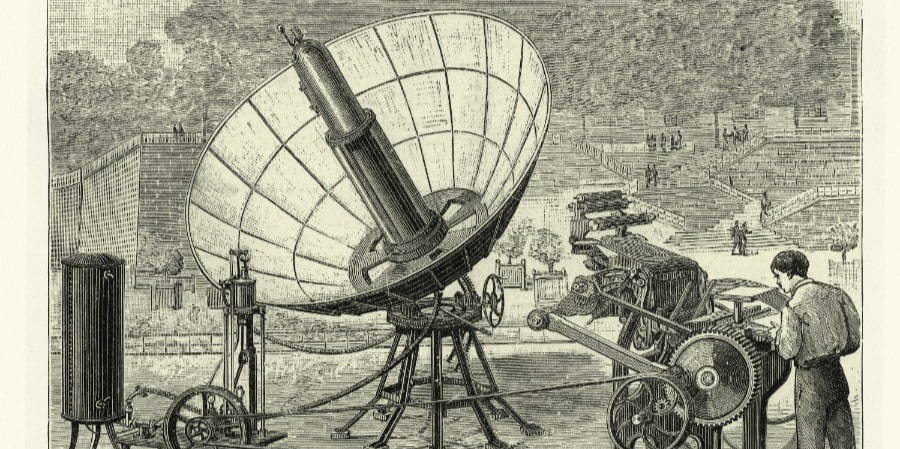A Brief History Of Solar Energy
07 Sept, 20224:36Although solar power is considered a power solution of the future, humans have been utilizin...

Although solar power is considered a power solution of the future, humans have been utilizing the sun’s energy for thousands of years. Through a host of innovative methods, the sun’s rays have been captured for use aeons before the first photovoltaic (PV) panel was even invented.
However technology progress was extremely slow until recently - in the last few decades, we’ve made leaps and bounds in the development of ever more efficient PV systems leading to solar power becoming the third-largest renewable electricity technology, accounting for 3.1% of global electricity generated, behind hydropower and wind energy.
But how has solar energy been used throughout the ages and what’s the status within the industry today?
Solar passive designs, solar mass, and magnification in Antiquity
The use of solar energy by humans can be traced back to the 7th century B.C. In Antiquity, different civilisations used passive solar designs for a range of different purposes.
The Greeks and Chinese designed whole cities with the sun, thermal mass, and ventilation in mind, positioning buildings so that they would remain cool during the summer and be heated by the sun’s rays during the winter. As stated by the philosopher Socrates,
‘It is pleasant to have one’s house cool in summer and warm in winter, is it not?... Now supposing a house to have a southern aspect, sunshine during winter will steal in under the veranda, but in summer, when the sun traverses a path right over our heads, the roof will afford an agreeable shade, will it not?
If, then, such an arrangement is desirable, the southern side of a house should be built higher to catch the rays of the winter sun, and the northern side lower to prevent cold winds finding ingress.’
These principles are still applied in many countries to this day.
Romans used the sun’s energy to heat their bathhouses. Using a process called a hypocaust, hot air circulated in hollow spaces beneath the floors, which were raised. The walls were also hollow so that the hot air and the water from the south-facing baths could create a steamy environment.
Through the design of their homes, Ancient Egyptians were able to use solar mass to trap the sun’s heat during the day, which was then released at night to keep their homes warm. They also used sunlight to evaporate water which then had a cooling effect on their homes.
The Romans and Greeks also used magnifying glasses and mirrors to light fires.

The creation of the first solar cell
In 1767, the Swiss physicist, naturalist, and geologist Horace Bénédicte de Saussure created the first solar collector cell. He designed an insulated box, a bit like a greenhouse, which had an opening and three to even five layers of glass.
When in direct sunlight, the glass magnified the sun’s heat which reached 108 degrees Celsius, enough to boil water and cook food.
This invention, which he called the heliothermometer, became the foundation of the solar collectors later developed in the 1800s and 1900s, which could heat houses, supply hot water, and generate electricity.

The discovery and potential of the photovoltaic effect
At 19 years old, French scientist Edmund Becquerel discovered the photovoltaic effect in 1839 whilst conducting research in his father’s lab.
Using an electrolytic cell composed of two metal electrodes placed in an electrolyte (a conductive solution), Becquerel found that sunlight could increase electricity generation. This discovery was a milestone in the history of solar energy.
Then, in the 1860s, August Mouchot, inspired by Becquerel’s work, began registering patents for solar-powered engines. These patents inspired scientists across the Americas and Europe.
In 1883, Charles Fritts designed the first solar cells made from selenium wafers, building upon the discoveries of Willoughby Smith, William Grylls Adams, and Richard Evans Day on selenium’s photoconductive properties.
Fritts’ invention had an efficiency of about one per cent. However, it was the first to demonstrate that solid material without any moving parts could be used to create electricity with sunlight.

From selenium to silicon solar cells
The next breakthrough in PV technology came in 1940, with Russell Shoemaker Ohl, a semiconductor researcher at Bell Labs.
Ohl was experimenting with silicon samples amongst which one had a crack in the middle. The researcher found that for that sample, a current flowed through it when exposed to light.
This crack formed a boundary between two segments with different levels of impurity, meaning one side was positive and the other negative. Inadvertently, Ohl had created a p-n junction, the basis of a solar cell.
As explained by the American Physical Society,
‘Excess positive charge builds up on one side of the p-n barrier, and excess negative charge builds up on the other side of the barrier, creating an electric field.
When the cell is hooked up in a circuit, an incoming photon that hits the cell can then give an electron a kick and start current flowing.’
Ohl patented the modern junction semiconductor solar cell in 1946.
The modern solar panels
The first practical solar cell was developed a few years later in 1954 by Daryl Chapin, Calvin Fuller, and Gerald Pearson, researchers at Bell Labs.
Using silicon wafers, the cell’s efficiency was a lot higher than Charles Fritts’ selenium cell, at around 6 per cent, higher than anything that had been previously achieved.
Bell Labs demonstrated the technology for the first time using it to power a small toy Ferris wheel and a solar-powered radio transmitter.
Following these discoveries, some of the first solar panels were used in space to power satellites. In 1958, the Vanguard I satellite used a small one-watt panel to power its radios. Other satellites including the Vanguard II, Explorer III and Sputnik-3 followed and to this day, solar energy is still very much used in space.

Solar power today
Over the decades, continuous improvements were made to solar power technology, reducing costs and improving efficiency, leading to the commercialisation of solar panels.
In 2016, researchers at The University of South Wales reached 34.5% efficiency. That same year, Bertrand Piccard completed the first flight around the world with zero GHG emissions, using the Solar Impulse 2, the world’s most powerful solar-powered aeroplane.
The use of solar energy has done nothing but increase over recent years. As stated in SolarPower Europe’s most recent Global Market Outlook for Solar Power,
‘for the 9th consecutive year, global solar power has broken its annual installation record with 168 GW of new solar PV capacity in 2021. In 2022, global solar is expected to continue the decade-long record-breaking streak, installing more than 200 GW of solar for the first time.’
NES Fircroft and the Solar Power industry
NES Fircroft is proud to be supporting the solar energy industry, and the Renewables sector more widely.
NES has a depth of expertise in the solar industry, a global network, and the local market knowledge to provide you with cost-effective energy workforce solutions. We know that the industry is changing and that the new generation of solar engineers need to be mobile, flexible, and work across the organisation to ensure knowledge is shared and competitive advantage is gained.
Our discipline-specific teams can support all stages of your solar project life cycle, from the funding, design and installation phases right through to project management, grid installations, and maintenance.
We work on some of the most exciting Renewable Energy projects globally, meaning we have plenty of renewable and solar job opportunities for engineers looking to enhance their careers in energy.










